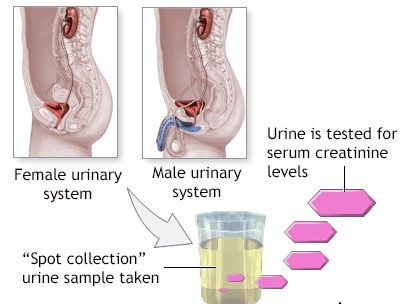A nurse is reviewing the laboratory reports of a client who is undergoing nutritional screening due to a risk for chronic kidney disease. The nurse should identify that which of the following results indicates the need for further assessment?
Serum creatinine 3.5 mg/dL
Hematocrit 45%
Blood urea nitrogen 18 mg/dL
Sodium 140 mEq/L
The Correct Answer is A
Choice A reason: Serum creatinine 3.5 mg/dL is high and indicates the need for further assessment. Creatinine is a waste product of muscle metabolism that is filtered by the kidneys. High creatinine levels can indicate kidney damage or impaired renal function.
Choice B reason: Hematocrit 45% is within the normal range (37-47% for women, 40-50% for men), and it does not indicate the need for further assessment. Hematocrit is the percentage of red blood cells in the blood. Low hematocrit levels can indicate anemia, bleeding, or hemolysis.
Choice C reason: Blood urea nitrogen 18 mg/dL is within the normal range (7-20), and it does not indicate the need for further assessment. Blood urea nitrogen is a waste product of protein metabolism that is filtered by the kidneys. High blood urea nitrogen levels can indicate dehydration, kidney damage, or high protein intake.
Choice D reason: Sodium 140 mEq/L is within the normal range (135-145), and it does not indicate the need for further assessment. Sodium is an electrolyte that helps maintain fluid balance, blood pressure, and nerve impulses. Low or high sodium levels can cause confusion, seizures, or coma.

Nursing Test Bank
Naxlex Comprehensive Predictor Exams
Related Questions
Correct Answer is D
Explanation
Choice A reason: Reporting ability to complete ADLs is not a specific finding that indicates that probiotic therapy is effective. Ability to complete ADLs depends on various factors, such as energy level, muscle strength, mobility, cognition, and motivation. Ability to complete ADLs may improve with parenteral nutrition, but not necessarily with probiotic therapy.
Choice B reason: Having pink mucous membranes is not a specific finding that indicates that probiotic therapy is effective. Pink mucous membranes reflect adequate hydration and oxygenation status, which are important for overall health, but not directly related to probiotic therapy.
Choice C reason: Having blood glucose level within the expected reference range is not a specific finding that indicates that probiotic therapy is effective. Blood glucose level is influenced by carbohydrate intake, insulin production, and medication use, which are related to parenteral nutrition, but not probiotic therapy.
Choice D reason: Having soft, formed bowel movements is a specific finding that indicates that probiotic therapy is effective. Probiotic therapy is the use of beneficial bacteria or yeast to restore the normal flora and function of the gastrointestinal tract, which can prevent or treat diarrhea, constipation, or infection. Having soft, formed bowel movements shows that the client has a healthy and balanced gut microbiome.

Correct Answer is D
Explanation
Choice A reason: Creatinine 0.8 mg/dL is within the normal range (0.6-1.2), and it does not indicate fluid volume excess. Creatinine is a waste product of muscle metabolism that is filtered by the kidneys. High creatinine levels can indicate kidney damage or impaired renal function.
Choice B reason: Hgb 15 g/dL is within the normal range (13-17 for men, 12-16 for women), and it does not indicate fluid volume excess. Hgb stands for hemoglobin, which is a protein in red blood cells that carries oxygen to the tissues. Low hemoglobin levels can indicate anemia, bleeding, or hemolysis.
Choice C reason: BUN 18 mg/dL is within the normal range (7-20), and it does not indicate fluid volume excess. BUN stands for blood urea nitrogen, which is a waste product of protein metabolism that is filtered by the kidneys. High BUN levels can indicate dehydration, kidney damage, or high protein intake.
Choice D reason: Sodium 149 mEq/L is high and indicates fluid volume excess. Sodium is an electrolyte that helps maintain fluid balance, blood pressure, and nerve impulses. High sodium levels can cause fluid retention, edema, hypertension, and heart failure.
Whether you are a student looking to ace your exams or a practicing nurse seeking to enhance your expertise , our nursing education contents will empower you with the confidence and competence to make a difference in the lives of patients and become a respected leader in the healthcare field.
Visit Naxlex, invest in your future and unlock endless possibilities with our unparalleled nursing education contents today
Report Wrong Answer on the Current Question
Do you disagree with the answer? If yes, what is your expected answer? Explain.
Kindly be descriptive with the issue you are facing.
